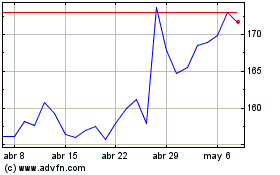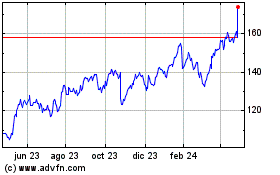Google Shows Off YouTube's Ad Heft -- WSJ
05 Febrero 2020 - 2:02AM
Noticias Dow Jones
By Patience Haggin
This article is being republished as part of our daily
reproduction of WSJ.com articles that also appeared in the U.S.
print edition of The Wall Street Journal (February 5, 2020).
If YouTube were a stand-alone company, it would be among the
biggest advertising players in the world. Yet the online video
service isn't as large as many outsiders expected.
Those were the revelations Monday when Google detailed YouTube's
financials for the first time in its fourth-quarter earnings
report.
There is a lot Google didn't say -- for example, how much profit
or loss YouTube makes. But this much is clear: YouTube is an
advertising and streaming juggernaut, and Google's 2006 acquisition
of the startup for $1.65 billion was one of the great bargains of
Silicon Valley history.
YouTube logged $15.1 billion in 2019 revenue, according to
figures released Monday by parent Alphabet Inc. The company said a
majority of those revenues get paid out to content creators.
YouTube's ad revenue landed on the lower end of Wall Street
estimates. Citi analysts had earlier pegged it at $19 billion,
while some other analysts had projected it was upward of $25
billion.
"When there's a black box, people's imaginations can run wild.
And I think that explains why expectations were all over the
place," said digital-ad consultant Ratko Vidakovic.
Regardless of Wall Street's expectations, as a separate business
YouTube would be the third-largest seller of advertising behind
Google's flagship online businesses and Facebook Inc.
YouTube's ad business -- on a gross basis, before the payouts to
creators -- is larger than that of Comcast Corp., which reported
about $13.9 billion in 2019 advertising revenue across several
different businesses. It is also larger than Amazon.com's $14.1
billion "other" revenue, which includes its ad business.
YouTube's $4.72 billion in fourth-quarter revenue isn't far from
that of Netflix Inc., its subscription-supported rival. Netflix
reported fourth-quarter revenue of $5.47 billion. Both YouTube and
Netflix reported similar growth rates of 31%.
The numbers give YouTube investors and executives reasons to
salivate over untapped room for growth. YouTube takes in between $7
and $8 a year in advertising for each of its two billion global
users -- monetizing them at a rate lower than other social
networks. Facebook, for instance, took in $8.52 per user just in
the fourth quarter alone. For users in lucrative markets like the
U.S. and Canada, it took in more than $41 per user.
Alphabet Chief Executive Sundar Pichai said on the earnings call
that this left the company "significantly more room" to generate
revenue from those users.
Among the bright spots in the disclosures: YouTube's
subscription services beat expectations. YouTube's $3 billion in
non-advertising revenue is mostly subscription revenue, Mr. Pichai
said. Live-TV service YouTube TV has over two million paid
subscribers -- a figure that would make it about the eighth most
popular pay-TV service, right behind traditional cable
providers.
YouTube's paid music and premium services has over 20 million
subscribers -- a figure that puts it in fourth place globally,
behind Spotify SA, Apple Inc. and Amazon.
Many questions about YouTube's overall business remain
unanswered, including its geographic revenue breakdown, what share
of advertising customers are large brands, its cost of revenue and
how much it spends policing content.
Ruth Porat, Alphabet's chief financial officer, said in the
Monday earnings call that YouTube has additional costs beyond the
payouts to creators, including for infrastructure, networking and
content responsibility efforts. She didn't provide a breakdown of
those costs.
YouTube's ad-revenue growth slowed in the fourth quarter -- a
surprise considering that the holiday season typically delivers a
boom quarter for ad-supported businesses.
Competition from Bytedance Inc.-owned video-sharing app TikTok
could have been a factor in the fourth-quarter slowdown, said Brian
Wieser, global president for business intelligence at ad agency
GroupM, owned by WPP PLC.
YouTube disclosed annual ad revenue going back as far as 2017.
Several large advertisers fled the platform in the spring of 2017
after news reports showed their ads were appearing next to content
promoting hate speech and terrorism. The exodus may have dented
YouTube's revenues in that year, providing favorable comparisons
for Google to showcase to Wall Street in the ensuing years, said
Mr. Wieser. Google reported $11.2 billion in YouTube ad revenue for
2018, up 37% from 2017.
Rob Copeland contributed to this article.
Write to Patience Haggin at patience.haggin@wsj.com
(END) Dow Jones Newswires
February 05, 2020 02:47 ET (07:47 GMT)
Copyright (c) 2020 Dow Jones & Company, Inc.
Alphabet (NASDAQ:GOOG)
Gráfica de Acción Histórica
De Mar 2024 a Abr 2024

Alphabet (NASDAQ:GOOG)
Gráfica de Acción Histórica
De Abr 2023 a Abr 2024
